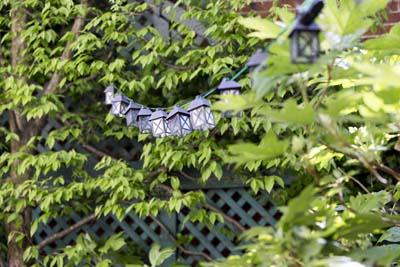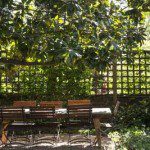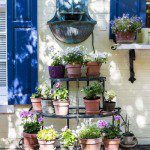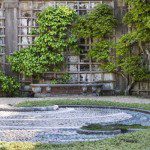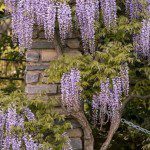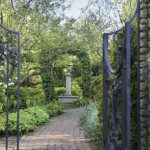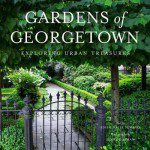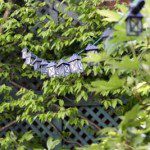Every year, eventually, spring comes to Washington.
The long-awaited season is an outward-bound explosion, an effusion of nature, basking in our admiration and seemingly pleased with itself for making it all look so easy.
Spring is bulbs, petals, digging shears and gardening shovels, blossoming trees, snaking vines, perennials and tulips and the fluttering, scooting, climbing critters that gad about in this profusion of natural wealth.
Here in Georgetown, spring is again the season of the Georgetown Garden Tour – the 87th annual – presented by the Georgetown Garden Club, an affiliate of the Garden Club of America, on Saturday, May 9, from 10 a.m. to 5 p.m. A tea with light refreshments will be served by garden club members from 2 to 4 p.m. at Christ Church, 3116 O St. NW.
Every garden tour is an opportunity to engage with one of the aspects of Georgetown that make it special, and so attractive to visitors. The tour offers ticket holders the chance to see – and take in with deep breaths – eight gardens, four each on Georgetown’s west and east sides.
“I believe that the garden tour and the garden club have had a tremendous effect on Georgetown. It’s very important to the community,” said Barbara Downs, a member and former president of the Georgetown Garden Club. “The proceeds alone have gone a long way to help preserve the natural quality of Georgetown, not just gardens, but foliage, trees, parks, places where we gather.”
Over the years, the Georgetown Garden Club, with proceeds of the tour and other fundraising efforts, has contributed to what it describes as “the greening of Georgetown, the tree-lined streets and the public parks.” Beneficiaries include Book Hill Park, the Georgetown Public Library, Montrose Park, Volta Park, Rose Park, Tudor Place Historic House and Garden, Trees for Georgetown, Dumbarton Oaks Park Conservancy and the Student Conservation Association.
This is about natural beauty, aided and abetted by particular people’s penchants for digging, growing, designing and beautifying, sometimes with the help of professional designers. Right here on earth, gardens mingle soil, trees, flowers, vegetation, pathways and works of sculptural art into an infinite variety of singular places.
This is not for just for show, but for civilized comfort, a way of living and looking. Here is where you can sit in an artful patio, to read, to commune, to dine, to enjoy a glass of wine in a space of one’s own.
Downs’s own garden has “a Japanese, Asian feel,” she said, and includes a bubbly fountain for birds, dogwoods and spring flowers, including irises and tulips.
To some extent, the annual garden tour always carries with it elements of mystery and serendipity. The yearly trek to homes and gardens in Georgetown reveals more than one secret of Georgetown living, not only the gardens themselves but the actual size and depth of the residences. This is revealed in the house tour, too, but the experience of patios and gardens adds to it.
From the view of a passerby, Georgetown’s homes always hide themselves a little. It’s hard to apprehend the actual size, the spaces, the depth and length of a house, not to mention its close proximity to others. (This does not include most mansions, which are very bold and rarely hidden.)
Tour sites range across Georgetown: 1248 30th St., 2824 O St., 1642 29th St., 3025 P St., 3413 P St., 3417 P St., 3314 O St. and 3327 N St.
On the east side, you’ll find a garden with pavement patterns in brick and limestone and columns of small bamboo. In another garden (a wrap-around) are fig trees, crepe myrtles, oakleaf hydrangeas, Italian pots. Yet another has a contemporary design, with grass steps, crepe myrtles in tubs and modern sculpture. In a large, historic garden in the center of the village, by a sweeping lawn with a pool, stand a large wall clock from a church tower in Provence and a marker showing Georgetown’s old boundary line.
On the west side, you’ll find a curvilinear, multilevel garden, with niches, an armillary sphere and a fishpond with aquatic plants. Nearby is a brick-paved garden with a French touch, including an aerial hedge, water features, hornbeams and espaliered camellias, all framed by a lattice fence. Elsewhere, a former carriage house offers an arched entrance with a wooden gate (once for horses), a tap pool and a hot tub. Another home features walks, gravel and a terrace. The owner’s love of plants is evident in three beds showcasing perennials, ferns and knockout yellow roses, as well as in the mature trees.
This year, the Georgetown Garden Club has published a book that not only serves as a companion to the tour but stands on its own. “Gardens of Georgetown: Exploring Urban Treasures” was written with great, understated grace by Georgetown author Edith Nalle Schafer.
Schafer, a genuine Georgetown citizen and treasure herself, has been a chronicler of Georgetown life for many years, through books, stories and essays. She has a gift for getting to the heart of what makes the village special. Her egalitarian style celebrates the village’s permanent things: buildings, churches and art, sidewalks and steeples, temperature and weather and the way all those things endure amid changes great and small.
Last week, the Georgetown Garden Club held a reception and book signing at the home of Jerry and June Libin on P Street. The evening, the place and the people there were a kind of reflection in miniature of what house and garden tours are about. After a slight drizzle during the evening, Libin, a noted tax attorney, stood in his own garden of trees, foliage, space and a covered pool and said, “I always love it out here after the rain. Everything feels fresh and new.”
“Gardens of Georgetown,” with spectacular, detailed photographs by Jenny Gorman, is a broadly painted but sharply detailed view of Georgetown as reflected in its gardens. In the book, Schafer defines our need for gardens, their purposefulness.
There is philosophy in this book. Sights are described directly with an economy of words that never lack impact. This goes for narrative text and for the photo captions that Schafer has helped along with quotes from philosophers and literary types (from Ralph Waldo Emerson to Virginia Woolf and the always astute “Unknown”).
Yet amid the pages, Schafer is her own best philosopher. She doesn’t need much help to describe what the photographs reveal. Her writing manages the difficult feat of being both pragmatic and entirely, hauntingly lovely.
Gardens are like that, too – having the all-at-once qualities of the necessary and the truly priceless. In digging up dirt, planting and contemplating the results, we manage to make art and gain a satisfaction properly enjoyed under trees, by a fountain, at night with the air fresh from rain and memory.
- Jordan Wright
- Jordan Wright

